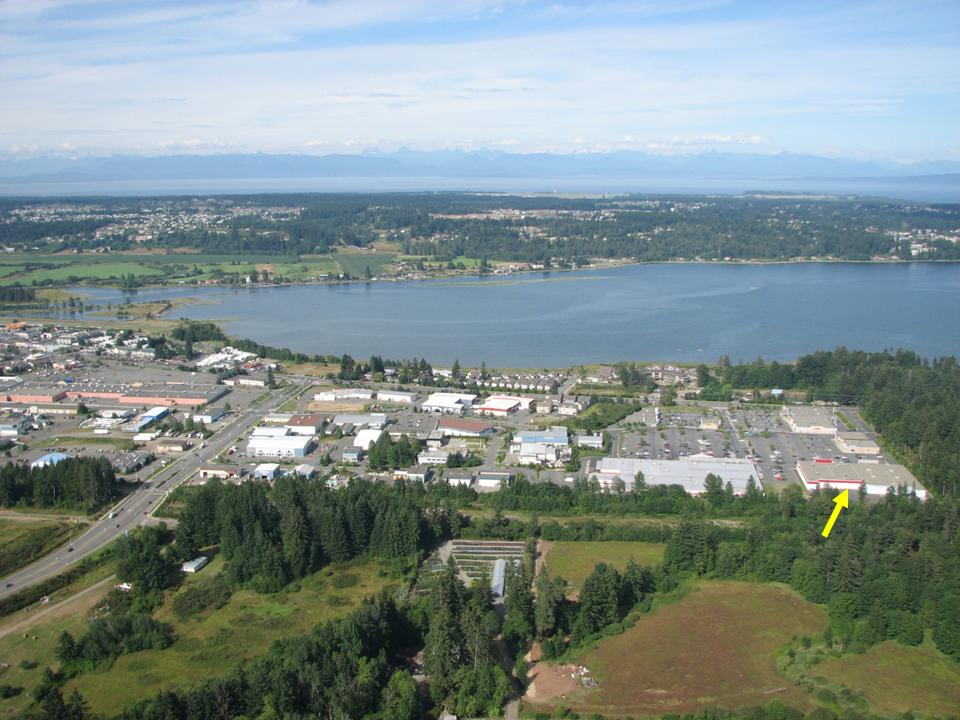Innovation in the Comox Valley: First Wal-Mart, Then Home Depot
Showcasing Green Infrastructure Innovation in the Comox Valley
The projected growth of Vancouver Island and resulting cumulative impacts are drivers for reassessing where and how land is developed, and water is used. To promote a new way-of-thinking related to infrastructure policies and practices, Convening for Action on Vancouver Island (CAVI) organized Showcasing Green Infrastructure Innovation on Vancouver Island: The 2007 Series.
The rainwater management plans for Wal-Mart and Home Depot were featured as part of Showcasing Green Infrastructure Innovatiion in the Comox Valley in October 2007. The event was co-hosted by the Comox Strathcona Reglonal District and the City of Courtenay. The theme for the event was ‘Connecting to Sustainability’.
Capturing Rain Where It Falls
Wal-Mart was the first big box store to come to the City of Courtenay. The 9.3-hectare  site includes additional commercial buildings. As the site was close to the Millard Creek and the Comox Harbour, there was a critical need to capture rainwater/stormwater, treat it and retain it in the catchment area.
site includes additional commercial buildings. As the site was close to the Millard Creek and the Comox Harbour, there was a critical need to capture rainwater/stormwater, treat it and retain it in the catchment area.
 According to Kevin Lagan, Director of Operational Services for the City of Courtenay, “The Wal-Mart development precipitated the beginning of a major change in how the City administers the zoning/development/approval process, collaborates with other agencies and also manages the rainwater resource.”
According to Kevin Lagan, Director of Operational Services for the City of Courtenay, “The Wal-Mart development precipitated the beginning of a major change in how the City administers the zoning/development/approval process, collaborates with other agencies and also manages the rainwater resource.”
First Deep-Well Application for Rainwater Runoff Injection in BC
The Home Depot development went beyond the Wal-Mart experience in terms of how rainwater runoff is captured and retained in the catchment area: Home Depot established a BC precedent when it implemented a deep deep-well system for injecting  rainwater runoff and recharging the underlying groundwater aquifer.
rainwater runoff and recharging the underlying groundwater aquifer.
The Home Depot site is located on a high point of land at the upstream end of the catchnment for Brooklyn Creek. Any drainage flows entering the creek are conveyed through the City of Courtenay, the Regional District and the Town of Comox prior to ocean discharge.
“Prior to development, the 4-hectare site was 100% forested, and therefore rainfall absorbing. The developed site is only 10% landscaped, with the other 90% now rainfall shedding,” explains Kevin Lagan, “The dramatic change in site characteristics meant rainwater runoff had to be captured to maintain a before development hydrologic regime, if the project was to avoid downstream impacts.”
“Through negotiations with the developer, government agencies and the use of a variety of innovative on-site rainwater/stormwater measures, we were able to achieve no rainwater runoff leaving the Home Depot property for storms occurring up to once in two years,” reports Kevin Lagan.
To Learn More:
To download a copy of the presentation by Kevin Lagan, click on Innovation in the Comox Valley: first Wal-Mart, then Home Depot. For more information, click on Showcasing Green Infrastructure Innovation in the Comox Valley.
Originally posted to the Green Infrastructure Community-of-Interest in October 2007




